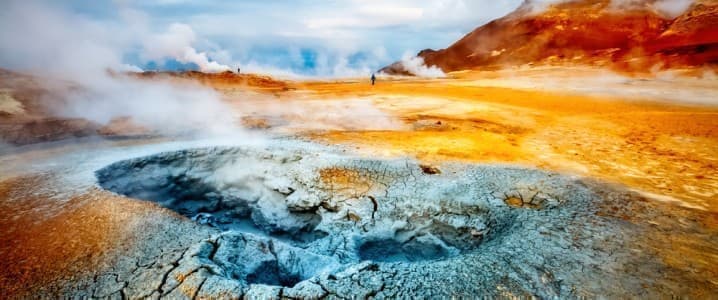A huge experiment to produce electricity using enhanced geothermal energy is taking place underground in Utah. The United States Department of Energy (DOE) is funding an experimental pilot project drilling well over a mile deep into the Earth’s crust to access a continuous heat source for clean energy production. While the technology is in its infancy and there are questions about whether enhanced geothermal could ever be cost-competitive with other forms of clean energy production, the DOE is convinced that it’s a good enough idea to spend hundreds of millions of dollars on.
Today, geothermal energy makes up a tiny fraction of energy production on a global scale. All told, it makes up less than 1% of the world’s primary energy supply. This is because currently, geothermal is only produced in geologically anomalous places where water carrying the residual heat of the Earth’s core has cracked through to the surface via hot water vents like hot springs or geysers. “Iceland, straddling two diverging tectonic plates, hits a geological jackpot and produces about a quarter of its electricity that way; in Kenya, volcanism in the Great Rift Valley helps push that figure to more than 40 percent,” Wired recently reported. “In the US, it’s just 0.4 percent, almost all of it coming from California and Nevada.”
The idea behind enhanced geothermal energy is that if you drill down deep enough, geothermal energy can be produced anywhere – not just the places where heat happens to be more accessible closer to the surface. Until recently, the idea was a bit more science fiction than fact, but drilling technologies have improved immensely thanks to the fracking boom of the last few decades. Whereas deep drilling and cracking through rock used to be a headache with little guarantee of success, it’s now a much more exact science.
What’s more, geothermal offers some extremely enticing benefits that other clean energies do not. First and most importantly, it’s a potential baseload power source, meaning that it produces steadily and continuously. This is a huge advantage over more popular renewable energies like wind and solar power, which are variable, as they depend on weather, seasons, and the time of day for production. And peaks of production rarely line up neatly with peaks of demand. This creates a huge challenge for the nascent energy storage sector, as well as our aging power grids, which were not designed with variable energy in mind. As such, a baseload clean energy source solves a number of the clean energy revolution’s most wicked problems – if it can be effectively scaled up and out.
Second, enhanced geothermal energy takes up much less surface area than other forms of renewable energy production. Land use is currently one of the biggest hurdles for clean energy expansion as disputes and competition for land tie up industrial-scale solar and wind farms around the country and around the world. Late last year, global management consulting firm McKinsey & Company released an analytic report naming land shortages as one of three key challenges facing the renewable revolution, along with long permitting processes and gravely under-prepared power grids. “Utility-scale solar and wind farms require at least ten times as much space per unit of power as coal- or natural gas–fired power plants, including the land used to produce and transport the fossil fuels,” McKinsey reports, adding that “wind turbines are often placed half a mile apart, while large solar farms span thousands of acres.” Since enhanced geothermal’s reach is down into the earth, and not across landscapes, it could be a key workaround for such issues.
While geothermal presents some key advantages and circumvents some of the biggest pitfalls of the renewable revolution, however, enhanced geothermal is still wickedly expensive, and by no means easy. While the up-front costs are considerable, however, the operational costs are relatively low. And once the heat source is tapped, it’s a gift that keeps on giving, forever. “The question is whether [enhanced geothermal systems] will be more or less practical than building a nuclear plant or a dam or installing carbon capture at a natural gas plant,” says journalist Gregory Barber, who has written about geothermal energy for Wired. “There are good reasons to think it will be—especially if you factor in safety and ecological concerns presented by the alternatives—but it's early.”
By Haley Zaremba for Oilprice.com
More Top Reads From Oilprice.com:
- Will The Steel Price Slide Help Drive The Auto Industry Forward?
- U.S. And China Locked In Underwater Tug-of-War
- Siemens Energy Reassesses Wind Strategy After £1.9 Billion Setback


















